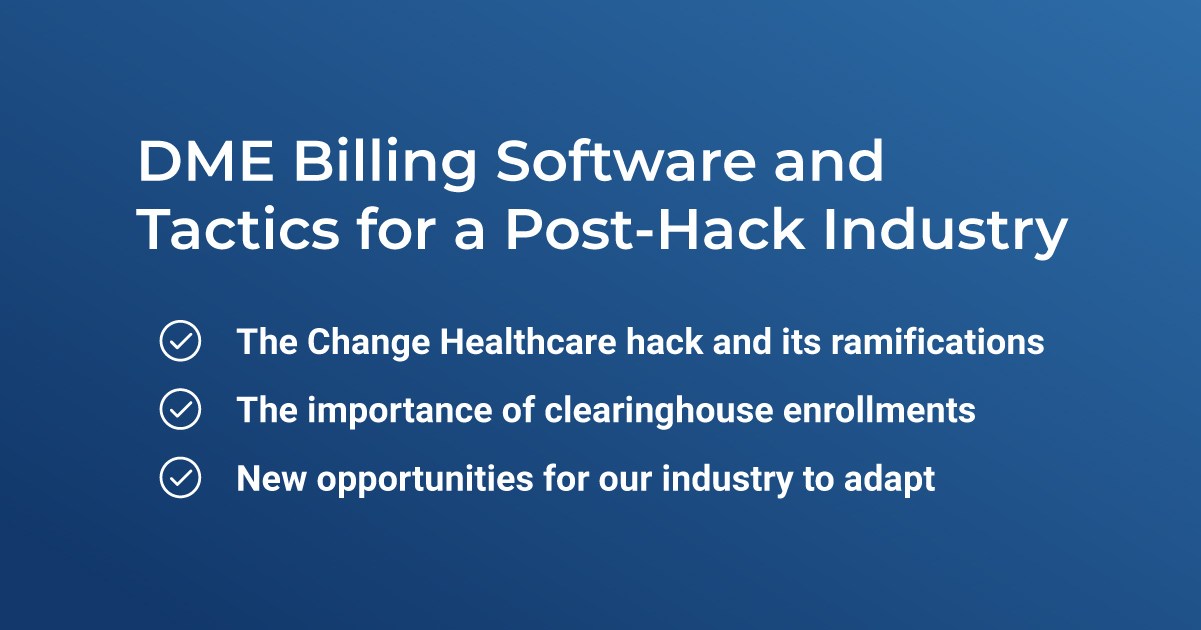IN THIS ARTICLE:
- The Change Healthcare hack and its ramifications
- The importance of clearinghouse enrollments
- New opportunities for our industry to adapt
Preparing for the Next Change Healthcare Hack
In February of 2024, the DME industry was shaken by an unforeseen cyberattack with lasting impacts that we are still reeling from. Change Healthcare, one of the largest clearinghouses in the market today, fell victim to a ransomware attack, causing major disruptions in claims processing for an unprecedented number of providers nationwide.
It’s been half a year since that incident, and our industry now stands at a crossroads: adapt to the changing security needs of our time or leave ourselves open to another devastating incident. The attack on Change Healthcare highlights the importance of robust and secure clearinghouse solutions. As the team behind the field’s most forward-thinking DME billing software, TrueSight is here to talk about it.
In this blog post, we’ll look at the events of February with the benefit of hindsight, evaluate some of the lasting ramifications, and shed some light on how providers can prepare against the possibility of future cyberattacks through strategic choices regarding clearinghouses and DME billing software.
Understanding Clearinghouse Enrollments
A clearinghouse in DME billing acts as an intermediary between providers and payers, streamlining the submission and processing of claims. The clearinghouse translates claims to a standardized format, checking for errors to reduce the administrative burden on billing teams. The result, in theory, is swifter reimbursement and a healthier revenue cycle.
The Enrollment Process
The process of enrolling with your clearinghouse of choice involves a few typical steps:
- Selecting a clearinghouse provider.
- Completing necessary enrollment forms.
- Submitting required documents, such as provider identification and billing information.
- Configuring electronic data interchange (or EDI) settings.
The exact details may vary depending on the clearinghouse and your practice, so be sure to speak with a clearinghouse representative for the most applicable details for you.
Let’s Talk About the Change Healthcare Hack
Clearinghouse enrollments play a critical role in DME billing, and in light of the recent events that have affected our industry, their importance is now underscored more than ever. In February of 2024, Change Healthcare was hacked by a group called BlackCat (or ALPHV). This caused a severe disruption to the clearinghouse’s operations, and in turn, a virtual standstill in payment for many dependent healthcare providers across the United States.
Impact on the DME Industry
The results of the attack were devastating for countless providers. At its peak, the disruption was estimated to cost the industry around $100 million per day. Even now, lasting effects persist. Even after Change Healthcare had resolved most of the issues, DMEs were left to work through a substantial backlog.
More than anything, this attack exposed the industrywide vulnerabilities of overreliance on a single clearinghouse for processing. Centralized claims processing puts DMEs in danger of complete billing failure in the event the clearinghouse is compromised.
Response and Decentralization
Increase in Direct Connections
In the wake of the hack, the industry has seen a noticeable shift toward direct connections between payers and providers. In addition to fostering quicker, more reliable claims submission, this practice also improves data security by reducing dependency on third-party clearinghouses.
Emergence of Multiple Clearinghouses
In addition to the increase in direct connections, the industry has also seen a notable increase in the number of clearinghouses overall. With a new awareness of the dangers of centralization, many providers began looking for new or additional clearinghouses to help manage their claims processing. Ultimately, this is a good thing — while more clearinghouses have the opportunity to carve a niche in the industry, providers now have more service options than ever before.
Vetting Your Ideal Clearinghouse
Your choice of clearinghouse is a major decision that will have lasting ramifications for your business and could mean the difference between financial success or unexpected challenges. When evaluating clearinghouses for service, be sure to consider factors like:
- Security measures and compliance with industry standards
- User interface and integration with DME billing software
- Timely responsiveness and quality of customer support
When vetting a clearinghouse, DMEs should always:
- Seek references and reviews from other users.
- Conduct thorough research on the clearinghouse’s track record.
- Verify compliance with industry regulations.
- Evaluate SLAs for uptime and support guarantees.
- Consider case studies and testimonials.
How DME Billing Software Protects You From Hacks
If the unfortunate fallout of the Change Healthcare hack teaches us anything, it’s the importance of exploring multiple clearinghouse options. More than that, it illuminates the dangers of single-avenue operations in general — “putting all your eggs in one basket,” so to speak.
In the aftermath, while many providers are still working to catch up, many more are exploring data security through diversified partnerships, superior DME billing software, and awareness of the dangers that plague our industry.
If your DME billing business is one of the thousands looking for new and innovative tools for the job, TrueSight is here to help. With forward-thinking features, cutting-edge data analysis, and a direct link to clearinghouses, your bottom line will always be in safe hands.
To learn more about the DME billing software that’s changing the industry as we know it, get in touch with TrueSight today. Demos are always free.
Explore the future of billing with us. Contact TrueSight for your FREE DEMO today.






